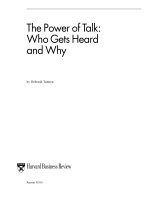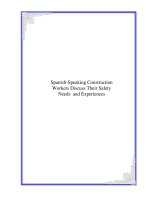Central Bank and FED pptx
Bạn đang xem bản rút gọn của tài liệu. Xem và tải ngay bản đầy đủ của tài liệu tại đây (12.91 MB, 25 trang )
Chapter 14
Structure of
Central Banks
and the Federal
Reserve System
Copyright © 2007 Pearson Addison-Wesley.
All rights reserved.
12-2
Origins of
the Federal Reserve System
•
Resistance to establishment of a central bank
Fear of centralized power
Distrust of moneyed interests
•
First U.S. experiments with a central bank terminated
in 1811 and in 1836
•
No lender of last resort
Nationwide bank panics on a regular basis
Panic of 1907 so severe that the public was convinced a
central bank was needed
•
Federal Reserve Act of 1913
Elaborate system of checks and balances
Decentralized
Copyright © 2007 Pearson Addison-Wesley.
All rights reserved.
12-3
Copyright © 2007 Pearson Addison-Wesley.
All rights reserved.
12-4
Copyright © 2007 Pearson Addison-Wesley.
All rights reserved.
12-5
Federal Reserve Banks
•
Quasi-public institution owned by private commercial
banks in the district that are members of the
Fed system
•
Member banks elect six directors for each district;
three more are appointed by the Board of Governors
Three A directors are professional bankers
Three B directors are prominent leaders from industry, labor,
agriculture, or consumer sector
Three C directors appointed by the Board of Governors
are not allowed to be officers, employees, or stockholders
of banks
Copyright © 2007 Pearson Addison-Wesley.
All rights reserved.
12-6
Federal Reserve Banks (cont’d)
•
Member banks elect six directors for each district;
three more are appointed by the Board of
Governors (cont’d)
Designed to reflect all constituencies of the public
•
Nine directors appoint the president of the bank
subject to approval by Board of Governors
Copyright © 2007 Pearson Addison-Wesley.
All rights reserved.
12-7
Functions of
the Federal Reserve Banks
•
Clear checks
•
Issue new currency
•
Withdraw damaged currency from circulation
•
Administer and make discount loans to banks
in their districts
•
Evaluate proposed mergers and applications
for banks to expand their activities
Copyright © 2007 Pearson Addison-Wesley.
All rights reserved.
12-8
Functions of
the Federal Reserve Banks (cont’d)
•
Act as liaisons between the business
community and the Federal Reserve System
•
Examine bank holding companies and state-
chartered member banks
•
Collect data on local business conditions
•
Use staffs of professional economists to
research topics related to the conduct of
monetary policy
Copyright © 2007 Pearson Addison-Wesley.
All rights reserved.
12-9
Federal Reserve Banks
and Monetary Policy
•
Directors “establish” the discount rate
•
Decide which banks can obtain discount loans
•
Directors select one commercial banker from
each district to serve on the Federal Advisory
Council which consults with the Board of
Governors and provides information to help
conduct monetary policy
•
Five of the 12 bank presidents have a vote in
the Federal Open Market Committee (FOMC)
Copyright © 2007 Pearson Addison-Wesley.
All rights reserved.
12-10
Member Banks
•
All national banks are required to be members
of the Federal Reserve System
•
Commercial banks chartered by states are not
required but may choose to be members
•
Depository Institutions Deregulation and
Monetary Control Act of 1980 subjected all
banks to the same reserve requirements as
member banks and gave all banks access to
Federal Reserve facilities
Copyright © 2007 Pearson Addison-Wesley.
All rights reserved.
12-11
Board of Governors
of the Federal Reserve System
•
Seven members headquartered in
Washington, D.C.
•
Appointed by the president and confirmed by
the Senate
•
14-year non-renewable term
•
Required to come from different districts
•
Chairman is chosen from the governors and
serves four-year term
Copyright © 2007 Pearson Addison-Wesley.
All rights reserved.
12-12
Duties of the Board of Governors
•
Votes on conduct of open market operations
•
Sets reserve requirements
•
Controls the discount rate through “review and
determination” process
•
Sets margin requirements
•
Sets salaries of president and officers of each
Federal Reserve Bank and reviews each
bank’s budget
Copyright © 2007 Pearson Addison-Wesley.
All rights reserved.
12-13
Duties of
the Board of Governors (cont’d)
•
Approves bank mergers and applications
for new activities
•
Specifies the permissible activities of
bank holding companies
•
Supervises the activities of foreign banks
operating in the U.S.
Copyright © 2007 Pearson Addison-Wesley.
All rights reserved.
12-14
Chairman of the Board of Governors
•
Advises the president on
economic policy
•
Testifies in Congress
•
Speaks for the Federal Reserve System
to the media
•
May represent the U.S. in negotiations
with foreign governments on
economic matters
Copyright © 2007 Pearson Addison-Wesley.
All rights reserved.
12-15
Federal Open Market
Committee (FOMC)
•
Meets eight times a year
•
Consists of seven members of the Board of
Governors, the president of the Federal
Reserve Bank of New York and the presidents
of four other Federal Reserve banks
•
Chairman of the Board of Governors is also
chair of FOMC
•
Issues directives to the trading desk at the
Federal Reserve Bank of New York
Copyright © 2007 Pearson Addison-Wesley.
All rights reserved.
12-16
FOMC Meeting
•
Report by the manager of system open market
operations on foreign currency and domestic open
market operations and other related issues
•
“Green Book” forecast
Go-round
•
Current monetary policy and domestic policy directive
“Blue book”
•
Presentation on relevant Congressional actions
•
Public announcement about the outcome of
the meeting
Copyright © 2007 Pearson Addison-Wesley.
All rights reserved.
12-17
Chairman Runs the Show
•
Spokesperson for the Fed and
negotiates with Congress and
the President
•
Sets the agenda for meetings
•
Speaks and votes first about
monetary policy
•
Supervises professional economists
and advisers
Copyright © 2007 Pearson Addison-Wesley.
All rights reserved.
12-18
How Independent is the Fed?
•
Instrument independent
•
Goal independent
•
Independent revenue
•
Structured by legislation from Congress and
accountable for its actions
•
Presidential influence
Influence on Congress
Appoints members
Appoints chairman although terms are
not concurrent
Copyright © 2007 Pearson Addison-Wesley.
All rights reserved.
12-19
European Central Bank
•
Patterned after the Federal Reserve
•
Central banks from each country play
similar role as Fed banks
•
Executive Board
President, vice-president and four
other members
Eight year, nonrenewable terms
•
Governing Council
Copyright © 2007 Pearson Addison-Wesley.
All rights reserved.
12-20
Differences
•
National Central Banks control their own
budgets and the budget of the ECB
•
Monetary operations are not centralized
•
Does not supervise and regulate
financial institutions
Copyright © 2007 Pearson Addison-Wesley.
All rights reserved.
12-21
Governing Council
•
Monthly meetings at ECB in
Frankfurt, Germany
•
Twelve National Central Bank heads and
six Executive Board members
•
Operates by consensus
•
ECB announces the target rate and takes
questions from the media
•
To stay at a manageable size as new countries
join, the Governing Council will
be on a system of rotation
Copyright © 2007 Pearson Addison-Wesley.
All rights reserved.
12-22
ECB Independence
•
Most independent in the world
•
Long terms
•
Determines own budget
•
Less goal independent
Price stability
•
Charter cannot by changed by
legislation; only by revision of the
Maastricht Treaty
Copyright © 2007 Pearson Addison-Wesley.
All rights reserved.
12-23
Central Bank Behavior
•
Theory of bureaucratic behavior—
objective is to maximize its own welfare
which is related to power and prestige
Fight vigorously to preserve autonomy
Avoid conflict with more powerful groups
•
Does not rule out altruism
Copyright © 2007 Pearson Addison-Wesley.
All rights reserved.
12-24
Case for Independence
•
Political pressure would impart an inflationary
bias to monetary policy
•
Political business cycle
•
Could be used to facilitate Treasury financing
of large budget deficits—accommodation
•
Too important to leave to politicians—the
principal-agent problem is worse for politicians
Copyright © 2007 Pearson Addison-Wesley.
All rights reserved.
12-25
Case Against Independence
•
Undemocratic
•
Unaccountable
•
Difficult to coordinate fiscal and
monetary policy
•
Has not used its independence
successfully









